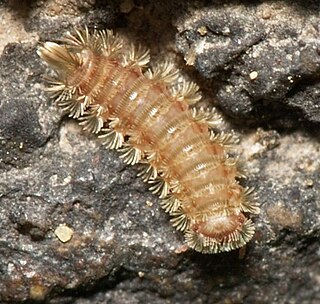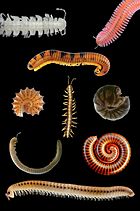
Arachnids are arthropods in the class Arachnida of the subphylum Chelicerata. Arachnida includes, among others, spiders, scorpions, ticks, mites, pseudoscorpions, harvestmen, camel spiders, whip spiders and vinegaroons.

Millipedes are a group of arthropods that are characterised by having two pairs of jointed legs on most body segments; they are known scientifically as the class Diplopoda, the name derived from this feature. Each double-legged segment is a result of two single segments fused together. Most millipedes have very elongated cylindrical or flattened bodies with more than 20 segments, while pill millipedes are shorter and can roll into a tight ball. Although the name "millipede" derives from Latin for "thousand feet", no species was known to have 1,000 or more until the discovery in 2020 of Eumillipes persephone, which can have over 1,300 legs. There are approximately 12,000 named species classified into 16 orders and around 140 families, making Diplopoda the largest class of myriapods, an arthropod group which also includes centipedes and other multi-legged creatures.

Centipedes are predatory arthropods belonging to the class Chilopoda of the subphylum Myriapoda, an arthropod group which includes millipedes and other multi-legged animals. Centipedes are elongated segmented (metameric) creatures with one pair of legs per body segment. All centipedes are venomous and can inflict painful stings, injecting their venom through pincer-like appendages known as forcipules or toxicognaths, which are actually modified legs instead of fangs. Despite the name, no species of centipede has exactly 100 legs; the number of pairs of legs is an odd number that ranges from 15 pairs to 191 pairs.

Symphylans, also known as garden centipedes or pseudocentipedes, are soil-dwelling arthropods of the class Symphyla in the subphylum Myriapoda. Symphylans resemble centipedes, but are very small, non-venomous, and only distantly related to both centipedes and millipedes. More than 200 species are known worldwide.

Chilognatha is a subclass of the class Diplopoda, which includes the vast majority of extant millipedes, about 12,000 species.

Myriapods are the members of subphylum Myriapoda, containing arthropods such as millipedes and centipedes. The group contains about 13,000 species, all of them terrestrial.

Arthropleuridea is an extinct subclass of myriapod arthropods that flourished during the Carboniferous period, having first arisen during the Silurian, and perishing in the Early Permian. Members are characterized by possessing diplosegement paranotal tergal lobes separated from the body axis by a suture, and by sclerotized plates buttressing the leg insertions. Despite their unique features, recent phylogenetic research suggests Arthropleuridea be included among millipedes in the class Diplopoda. The subclass contains three or two recognized orders, each with a single genus.

Arthropleura is a genus of massive myriapod that lived in what is now Europe and North America around 345 to 290 million years ago, from the Viséan stage of the lower Carboniferous Period to the Sakmarian stage of the lower Permian Period. It is related to millipedes, and was capable of reaching at least 2 metres in length, possibly up to over 2.5 metres, making it the largest known land arthropod of all time. Arthropleura is known from body fossils as well as trace fossils, particularly giant trackways up to 50 centimetres (20 in) wide, and potentially also large burrows. It lived in open, sparsely wooded environments near water, and was possibly amphibious.
Euphoberia is an extinct genus of millipede from the Pennsylvanian epoch of the Late Carboniferous, measuring up to 15 centimetres (5.9 in) in length, that is small in Euphoberiidae which contains species with length about 30 centimetres (12 in). Fossils have been found in Europe and North America.

Scutigeromorpha is an order of centipedes also known as house centipedes. These centipedes are found in the temperate and tropical parts of every continent except Antarctica, with their distribution significantly expanded by the introduction of the Mediterranean species Scutigera coleoptrata throughout Europe, Asia, and North America. The common species S. coleoptrata is a typical representative of this order, lying in wait for other arthropods, then seizing prey using great speed, and all species in this order reflect adaptations for this mode of life.

Arthropods are invertebrates in the phylum Arthropoda. They possess an exoskeleton with a cuticle made of chitin, often mineralised with calcium carbonate, a body with differentiated (metameric) segments, and paired jointed appendages. In order to keep growing, they must go through stages of moulting, a process by which they shed their exoskeleton to reveal a new one. They form an extremely diverse group of up to ten million species.

Attercopus is an extinct genus of arachnids, containing one species Attercopus fimbriunguis, known from flattened cuticle fossils from the Panther Mountain Formation in Upstate New York. It is placed in the extinct order Uraraneida, spider-like animals able to produce silk, but which lacked true spinnerets and retained a segmented abdomen bearing a flagellum-like tail resembling that of a whip scorpion. They are thought to be close to the origins of spiders.

Sphaerotheriida is an order of millipedes in the infraclass Pentazonia, sometimes known as giant pill millipedes. They inhabit Southern Africa, Madagascar, South and Southeast Asia, Australia and New Zealand. Like the Northern Hemisphere pill millipedes of the order Glomerida, these millipedes can roll into a ball when disturbed. When they are rolled-up, most sphaerotheriidans reach a maximum size of a cherry or golf ball, but some species from Madagascar can even reach the size of an orange. When rolled-up, predators are unable to unravel giant pill millipedes since the margins of their second and last dorsal plates fit perfectly into one another, creating a sealed ball. A few giant pill millipede species are able to produce sound, the only millipedes known to do this. This order of millipedes is also unique in that some African species are used for medicinal purposes.

Polyxenida is an order of millipedes readily distinguished by a unique body plan consisting of a soft, non-calcified body ornamented with tufts of bristles. These features have inspired the common names bristly millipedes or pincushion millipedes. This order includes about 148 species in four families worldwide, which represent the only living members of the subclass Penicillata.

Archipolypoda is an extinct group of millipedes known from fossils in Europe and North America and containing the earliest known land animals. The Archipolypoda was erected by Scudder (1882) but redefined in 2005 with the description of several new species from Scotland. Distinguishing characteristics include relatively large eyes with densely packed ocelli, and modified leg pairs on the 8th body ring. Some species had prominent spines while others had a flattened appearance.
The Panther Mountain Formation is a geologic formation in New York. It preserves fossils dating back to the Devonian period. It is located in the counties of Albany, Madison, Oneida, Otsego, and Schoharie. It is well known for its fossil arthropods preserved as flattened cuticles, including Attercopus and Dracochela.

Euphoberiidae is an extinct family of archipolypodan millipedes known from the Upper Pennsylvanian of Europe and North America. The family includes relatively large millipedes measuring up to 30 cm (12 in) long bearing distinctive spines and were the dominant millipedes of the Pennsylvanian.

Palaeosoma is an extinct genus of archipolypodan millipedes from the upper Carboniferous of England and Poland. Individuals grew to nearly 20 cm (7.9 in) long and possessed defensive glands (ozopores) located on small raised nodes on the outer edges of the upper surface of each body segment. Species of Palaeosoma were once considered members of the family Euphoberiidae, which contains species with prominent spines, but are now classified in their own family (Paleosomatidae) and own order (Palaeosomatida), as they lack spines and have a combination of features not seen in other Paleozoic millipedes.

Kampecaris is an extinct genus comprising the Kampecarida, an enigmatic group of millipede-like arthropods, from the Silurian and early Devonian periods of Scotland and England. They are among the oldest known land-dwelling animals. They were small, short-bodied animals with three recognizable sections: an oval head divided along the midline, ten limb-bearing segments forming a cylindrical trunk that tapered slightly towards the front, and a characteristic swollen tail formed by a modified segment that tapers at its rear into an "anal segment". The cuticle forming their exoskeletons was thick, heavily calcified, and composed of two layers.




















